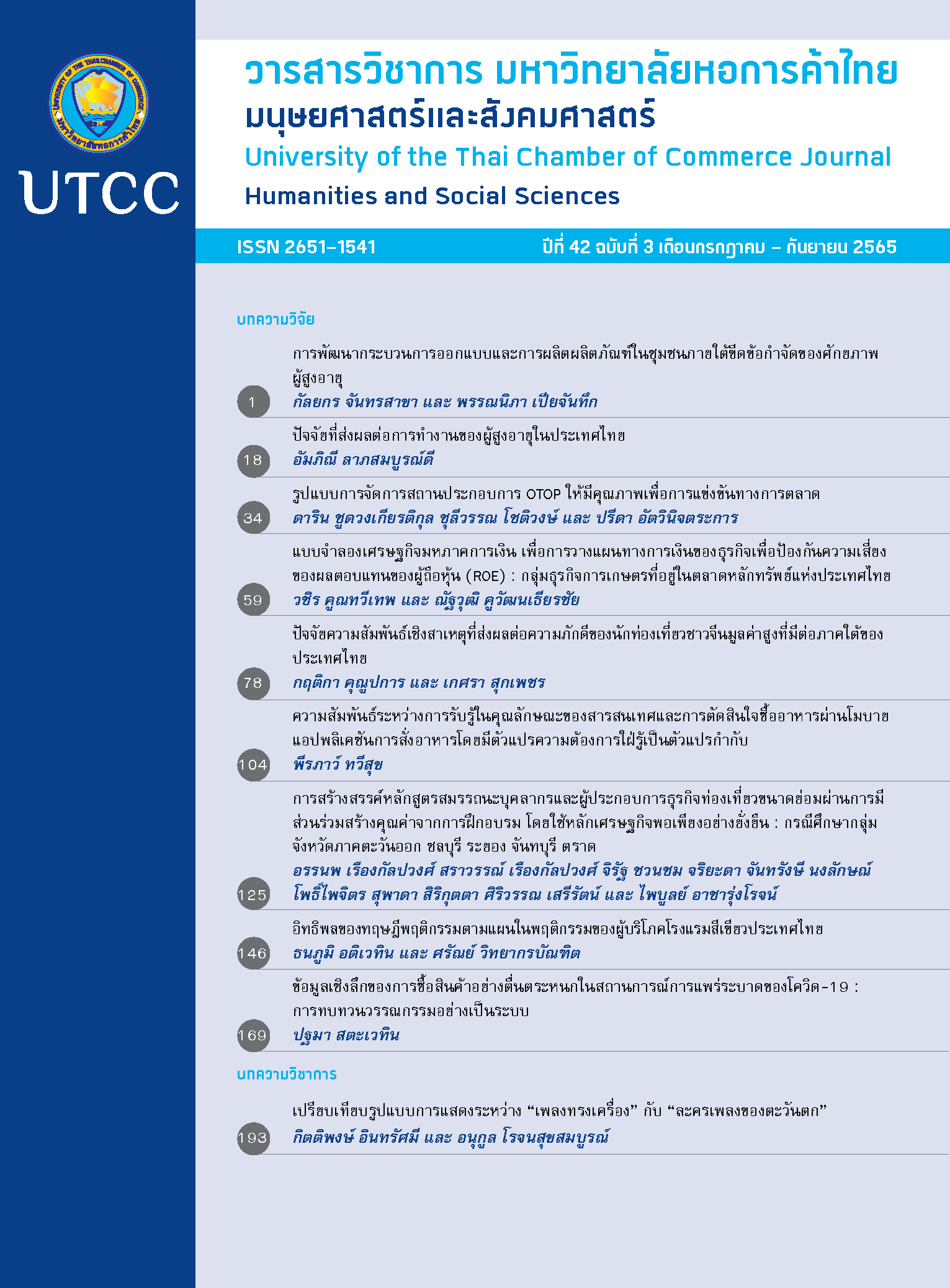OTOP Entreprises Management Model in Marketing Competitiveness
Main Article Content
Abstract
The objectives of this research were to study the elements of OTOP entreprise management in marketing competitiveness, and create the OTOP entreprise management model in marketing competitiveness. This mixed methods research was qualitative and quantitative research. Data were collected by in-depth interviews and questionnaires. The sample was 600 OTOP entrepreneurs who was selected for four or five-stars products in 2019 selected by multi-stage sampling. Data were analyzed by content analysis and statistics such as frequency, percentage, mean, standard deviation and Exploratory Factor Analysis: EFA. The findings revealed that the organizational factors of OTOP entreprise management in marketing competitiveness consisted of 6 factors as follows: 1) Planning, 2) Budgeting, 3) Directing, 4) Engagement, 5) Innovation networking and 6) Reporting. Moreover, marketing management consisted of 2 factors as follows: 1) Production technology and 2) Digital marketing. The OTOP entreprise management model in marketing competitiveness was verified in the focus group discussion by the experts with consensus agreement. This model could be applied in the OTOP business management to enhance the sustainability of competitive capacity related to business operations.
Article Details

This work is licensed under a Creative Commons Attribution-NonCommercial-NoDerivatives 4.0 International License.
ลิขสิทธิ์ของบทความ
ผลงานที่ได้รับการตีพิมพ์ถือเป็นลิขสิทธิ์ของมหาวิทยาลัยหอการค้าไทย ห้ามมิให้นำเนื้อหา ทัศนะ หรือข้อคิดเห็นใด ๆ ของผลงานไปทำซ้ำ ดัดแปลง หรือเผยแพร่ ไม่ว่าทั้งหมดหรือบางส่วนโดยไม่ได้รับอนุญาตเป็นลายลักษณ์อักษรจากมหาวิทยาลัยหอการค้าไทยก่อน
References
กรมการพัฒนาชุมชน. (2564). รายงานผลการจำหน่ายสินค้าตามโครงการหนึ่งตำบลหนึ่งผลิตภัณฑ์. สืบค้นเมื่อ 3 พฤศจิกายน 2564, จาก http://logi.cdd.go.th/cddcenter/cdd_report/otop_r10.php?&year=2564&org_group=0
ณฐมน กัสปะ, และฐิตารีย์ ศิริมงคล. (2564). ส่วนประสมทางการตลาด 4C’s ที่ส่งผลต่อการตัดสินใจซื้อสินค้าผ่านสื่อสังคมออนไลน ์ (เฟสบกุ๊ ) ของผู้บริโภคในจังหวัดขอนแก่น . วารสารวิชาการและวิจัย มหาวิทยาลัยภาคตะวันออกเฉียงเหนือ, 11(1), 100-114.
ทิชากร เกษรบัว, และฌานนท์ ปิ่นเสม. (2561). กลยุทธ์การพัฒนาผู้ประกอบการสินค้าหนึ่งตำบลหนึ่งผลิตภัณฑ์(OTOP) กลุ่มเบญจบูรพาสู่การค้าชายแดนไทย-กัมพูชา (ด่านอรัญประเทศ) ด้วยการวิเคราะห์ SWOT.วารสารวิชาการคณะบริหารธุรกิจ มหาวิทยาลัยราชมงคลธัญบุรี, 13(2), 51-65.
บุริม โอทกานนท์. (2556, 6 กันยายน). 4C’s การตลาดปฏิวัติ [บล็อก]. สืบค้นจาก https://www.gotoknow.org/posts/245074
ปานศิริ พูนพล, และทิพวรรณ พรมลาย. (2560). ปัญหาและแนวทางการพัฒนาการตลาดของผู้ประกอบการผลิตภัณฑ์ OTOP (ระดับ 1-5 ดาว) ในจังหวัดขอนแก่น. วารสารวิทยาลัยบัณฑิตเอเซีย, 7(ฉบับพิเศษ),23-33.
พัชรี ฉลาดธัญกิจ, ขวัญมิ่ง คำประเสริฐ, เกรียงไกร โพธิ์มณี, และสุภาภรณ์ พรหมฤๅษี. (2558). การพัฒนารูปแบบการจัดการแบบมีส่วนร่วมของผู้ผลิตผ้าทอฝ้ายที่เป็นมิตรกับสิ่งแวดล้อมในภาคเหรือตอนล่างของประเทศไทย. วารสารวิชาการ มหาวิทยาลัยราชภัฏพระนคร, 6(2), 246-255.
เมธารัตน์ จันตะนี, ธีร์ธนิกษ์ ศิริโวหาร, และบุญเรือง ศรีเหรัญ. (2560). รูปแบบความสัมพันธ์เชิงสาเหตุที่ส่งผลต่อความสามารถในการแข่งขันของธุรกิจ OTOP ในประเทศไทย. วารสาร มจร สังคมศาสตร์ปริทัศน์, 6(2), 197-209.
รัตนา อัตภูมิสุวรรณ์, และธานินทร์ ศิลป์จารุ. (2564). แนวทางการบริหารธุรกิจหนึ่งตำบลหนึ่งผลิตภัณฑ์ด้วยวิถีพุทธสู่การพัฒนาอย่างยั่งยืน. วารสารมนุษยศาสตร์และสังคมศาสตร์ มหาวิทยาลัยนครพนม, 11(1),160-175.
วารีพร ชูศรี. (2562). การบริหารจัดการกลุ่มผลิตภัณฑ์ชุมชนหนึ่งตำบลหนึ่งผลิตภัณฑ์: กรณีศึกษา บ้านห้วยยาง ตำบลเมืองหลวง อำเภอห้วยทับทัน จังหวัดศรีสะเกษ. วารสารมหาวิทยาลัยราชภัฏมหาสารคาม, 13(3),107-114.
วิโรจน์ เจษฎาลักษณ์, และวัลยา ก๋ำรามัญ. (2560). กลยุทธ์การสร้างความได้เปรียบทางการแข่งขันของโครงการหนึ่งตำบลหนึ่งผลิตภัณฑ์ กรณีศึกษา: บ้านลูกประคบสมุนไพร อำเภอพระประแดง จังหวัดสมุทรปราการ.Veridian E-Journal, Silpakorn University ฉบับสาขามนุษยศาสตร์ สังคมศาสตร์ และศิลปะ, 10(3),2007-2016. สืบค้นจาก https://he02.tci-thaijo.org/index.php/Veridian-E-Journal/article/
view/110244/86486
อณิษฐา หาญภักดีนิยม, และศิริขวัญ ปัญญาเรียน. (2562). การพัฒนาผลิตภัณฑ์ OTOP สู่ตลาดอาเซียนตามแนวพุทธ. วารสารวิทยาลัยสงฆ์นครลำปาง, 8(1), 108-121.
อัยรดา พรเจริญ, จันทร์ทิวา ทามาดาร, ทิพย์วิภา สีหนันท์, และเบญจมาศ คำแพงจีน. (2563). การบริหารจัดการส่วนประสมทางการตลาดและพฤติกรรมการซื้อที่มีต่ออิทธิพลต่อกระบวนการตัดสินใจซื้อผลิตภัณฑ์โอทอปในจังหวัดอุบลราชธานี. วารสารปัญญาภิวัฒน์, 12(2), 30-42.
อาทิมา วงษ์สีมาอนันต์, และชมภูนุช หุ่นนาค. (2563). การพัฒนาการท่องเที่ยววิถีชุมชนควบคู่ผลิตภัณฑ์สินค้าOTOP ในอำเภอสามพราน จังหวัดนครปฐม. วารสารนวัตกรรมการบริหารและการจัดการ, 8(3), 40-55.
อุทิศ ทาหอม, จริยา ดวดไธสง, และอันธิกา คงประโคน. (2561). แนวทางการบริการจัดการกลุ่มทอผ้าไหมบ้านหนองไทรงาม ตำบลชุมเห็ด อำเภอเมือง จังหวัดบุรีรัมย์. วารสารพัฒนศาสตร์, 1(1), 97-129.
อุษา โบมานน์. (2558). รูปแบบการพัฒนาผู้ประกอบการอุตสาหกรรมโอทอปภายใต้ปรัชญาเศรษฐกิจพอเพียง(วิทยานิพนธ์ปริญญาดุษฎีบัณฑิต ไม่ได้ตีพิมพ์). มหาวิทยาลัยเทคโนโลยีพระจอมเกล้าพระนครเหนือ,กรุงเทพฯ.
Bartol, K. M., & Martin, D. C. (1998). Management (3rd ed.). New York, NY: McGraw-Hill.
Dubrin, A. J., & Ireland, R. D. (1993). Management and organization (2nd ed.). Cincinnati, OH:South Western.
Fayol, H. (1999). General and industrial management. London, England: Pitman.
Gulick, L., & Urwick, L. (1973). The science of administration. New York, NY: Columbia University.
Hiramatsu, M. (1999). Think Globally-The One Village, One Product Movement Transcends Generation and National Borders. Keynote Speech in International Symposium in Commemoration of International Cooperation Day 1999, October 20, 1999 at Sankai Hall, Sankei Kaikan 5F,Tokyo, Japan.
Jamieson, S. (2004). Likert scales: How to (ab)use them? Medical Education, 38(12), 1217-1218.
Kaiser, H. F. (1970). A second generation little jiffy. Psychometrika, 35(4), 401-415.
Koontz, H., & O’ Denell, C. (1982). Principle of management: An analysis of management function(5th ed.). New York, NY: McGraw-Hill.
Kotler, P., & Kevin, L.K. (2016). Marketing management (15th ed.). Boston, MA: Pearson.
Kotler, P., Kartajaya, H., & Setiawan, I. (2019). Marketing 4.0. New York, NY: Wiley.
Kuratko, D. F., & Hodgetts, R. M. (1998). Entrepreneurship: A contemporary approach. New York,NY: Dryden Press.
Kurokawa, K. (2009). Effectiveness and limitations of the One Village One Product (OVOP) approach as a government-led development policy: Evidence from Thai OTOP studies in regional science. The Journal of the Japan Section of the Regional Science Association International, 39(4), 809-821.
Lauterborn, B. (1990). New marketing litany; Four Ps passe; C-words take over. Advertising Age,61(41), 26.
Straub, J. T., & Raymond, F. A. (1985). Introduction to business (2nd ed.). Boston, MA: Kent.
Yamane, T. (1973). Statistics: An introductory analysis (3rd ed.). New York, NY: Harper & Row.


